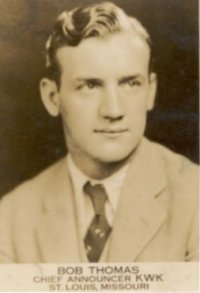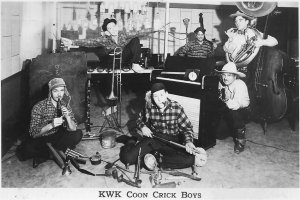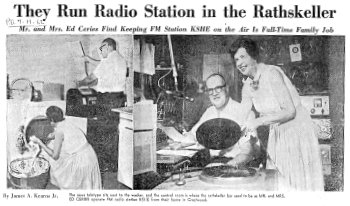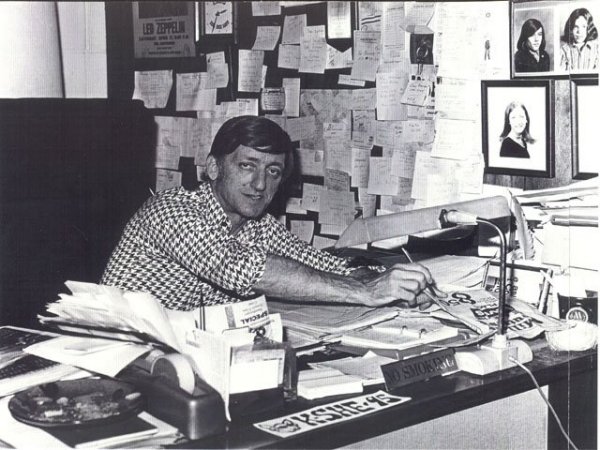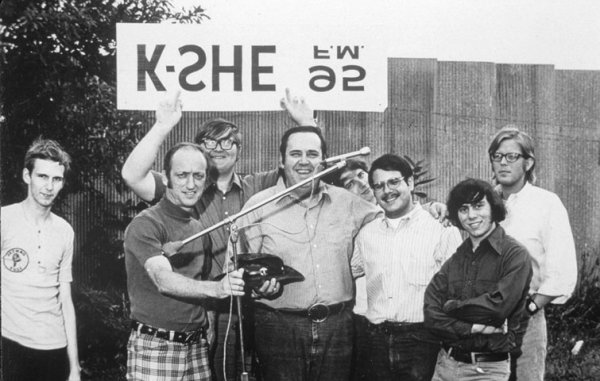Anyone who ever worked at the “Old” KSHE has vivid memories of “the window,” that small aperture in the studio wall that served as the connection point between the deejay and the outside world. The cinder block building in Crestwood became a virtual mecca for rock music fans, and “The Window” was their blarney stone.
In the words of former KSHE jocks:
Gary Bennett: “I helped a guy one night find his lost dog. I went on the air and said where this fella lived and described his dog. Sure enough, two days later there’s a knock on the window and it was this guy. Somebody had found his dog. He was so appreciative he gave me a big chunk of hash and a couple of candy bars.”
Sir Ed: “Of course, people would come up and knock on the window. That’s how I met my wife. John Williams was really good friends with my wife’s friend. And she had befriended me. She worked at a couple bars and John would get free drinks from time to time. The two women came out one Sunday to get tickets and that’s how I first met my wife.”
John Williams: “The window had curtains, and if you kept the curtains open, everyone could see you. Your back was to the window and you’d have to turn around to see someone. They’d hold up notes. They’d bring you food. They’d bring you dope. They’d ask you for dope. If you opened that window it was like a floodgate. I had incredible experiences through the window.”
Steve Rosen: “I remember one time I was at KSHE and somebody knocked on the window and it was Chuck Berry and his girlfriend. And he came in and we interviewed him. He just came in, sat down and talked. He knew Shelley [Grafman, one of the station owners].”
Don Corey: “People would come and knock on the window which could be frightening at 3 in the morning. A lot of the time they just wanted to talk. Some would buy tickets. Sometimes there’d be a group of six or seven people just standing around talking.”
For Joy Grdnic, being a woman on the air meant there were plenty of window visitors, but for a different reason than most of the other jocks. “People would come to the window just to see what I looked like.”
Bob Burch: “The window was really fun when the streaking fad hit. The girls would come up and press their breasts against the glass. We always had a bunch of characters coming up there. I had a guy put a gun up to the window once. Then he turned around and ran away laughing. I’d keep the curtain closed.”
Ken Suitter: ““It was nothing to hear a knock at the window and turn around in your chair and a naked woman would be standing at the window. The window, you got to meet all kinds there. People offered you drugs. I remember people coming down to the window with a barbecue pit, and the guy said he didn’t have anything else to do so he decided to come down and cook me a steak.”
Loren Cornelius: “If you were doing 7:00 to midnight or midnight to 6:00 you’d turn around and there’s be people at the window and it’d scare the shit out of you. Most of them were stoned out of their minds when they showed up.”
Joe “Mama” Mason: “You really could talk to the listeners. You could crank the window open. One time a guy came up and knocked on the window and asked if I remembered him. He was about 22 years old. I didn’t remember him. He said ‘I came here four years ago and talked with you and you talked to me all night long. I was just out of high school. I’m here to thank you. You talked me into going to college. I just graduated and I’m here to thank you. You were the only reason I went to college.’
“When I was really in the thick of things, every single night there’d be at least 10 girls who would come up and take their tops off at the window. It was really that crazy.
“There were girls just coming out of the woodwork. They’d show up at the studio or take their clothes off at the window.”
Rich Dalton: “The world famous KSHE window became a rite of passage in St. Louis. Especially on weekends, people would come and party at the KSHE window. And as crazy as it seems now, t-shirts and concert tickets were sold out that window by deejays. One deejay was busted by a St. Louis County cop for selling dope out that window.”
For Brother Love, who had the wake-up shift on KSHE, the window wasn’t sex and drugs. It was rock and roll. “The record guys would come by before the station opened. They’d come to the window and bring me the new records.”
Al Hofer: “I think if you want to build a legendary radio station and you want to reach out and touch the community, you need a window like KSHE had.
“When I would do weekends, people would literally come up there when I was on and hang out all night long. I was on from 7 ‘til midnight Saturdays and Sundays, and they would bring their coolers and other party paraphernalia and hang out, occasionally request songs, but it was a party.
“People would come from miles around. There was this great mystique about the station. And the fact that the tower was right there was extremely cool too.
Mark Klose: “Behind you on the back wall was the window, like a transom window that leaned in. You’d be on the air and they’d stick their head by the window and call out to you. Some of them would reach in while you were on the air and grab some records and take off.”
Ted Habeck: “I remember getting the shit scared out of me a lot from that window. The station wouldn’t spend $5.00 for a mirror so you could see it when you were on the air. Invariably somebody would wait until you opened the microphone before they’d come banging on the window.”
Gary Kolander: “You’d be there doing the overnight shift and all of a sudden at 3:30 in the morning BAM, BAM, BAM on the window. It’d scare the hell out of you.
“There was one New Years’ Eve I’ll never forget where this blond came up with two glasses of champagne. She handed me one through the window and said she’d just come up to wish me a happy new year. We toasted, and I said ‘Just a minute, the song’s ending.’ And she said ‘Happy New Year,’ and she lifted up her shirt and pressed against the glass. I’ve got about five seconds left on the song I was a little flustered, to say the least. I got the next record going. It took maybe 30 seconds. I turned around and she was gone.”
KSHE’s window went the way of all great legends when the station moved from its infamous cinder block studios in Crestwood to their downtown location at Union Station, and with the move a part of rock radio’s fabric was lost.
(Reprinted with permission of The St. Louis Journalism Review. Originally published 1/2-10).
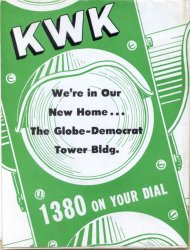
 Ed would often hold me through a commercial so I was trapped when he went back on the air. And, he frequently used these opportunities to give me a hard time – ‘Well, well, little Bobbie, the son of the boss. Isn’t that uniform cute?’ and ‘Do you have a girlfriend?’
Ed would often hold me through a commercial so I was trapped when he went back on the air. And, he frequently used these opportunities to give me a hard time – ‘Well, well, little Bobbie, the son of the boss. Isn’t that uniform cute?’ and ‘Do you have a girlfriend?’